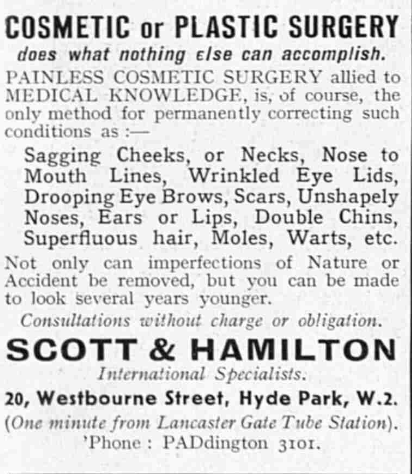20th Century British Aesthetic Surgery
The origins of aesthetic or cosmetic surgery in Britain lie within the overall evolution of reconstructive surgical methods in the late 19th and early 20th centuries.
Whilst the inspiration for initial breakthroughs was the reconstruction of disfigurement from injury or disease, there was always an implied but increasing interest in operations that treated only appearance.
Although beginning in Britain during the mid-to-late 1800s, regular aesthetic surgery commenced in the Harley Street clinics of Edwardian times (1900-1910). These were small operations—to the nose (rhinoplasty), reconstructive ear work, and removing excess skin—all performed by surgeons for remuneration. These were “discretionary” procedures, not undertaken purely to benefit physical health. Operations, at the time, often referred to as "cosmetic" rather than "aesthetic", or “plastic” would typically be performed clandestinely, with minimal paper records. This was in an era when “Plastic Surgery” was in its earliest phases as a recognised surgical specialty, and so there was no organised training of surgeons in these procedures. Moreover, some high-profile practitioners had no formal medical qualifications at all! They contributed to the poor reputation of the discipline in its early years.
The First World War was a watershed. Early plastic surgeons like Sir Harold Gillies, who operated at Queen Mary’s Hospital, Sidcup, evolved extremely sophisticated techniques for reconstructing faces broken by trench warfare. Although reconstructive, Gillies recognised at an early stage that there was an artistic component to these operations, requiring an appreciation of symmetry, proportion, and appearance. Gillies' also appreciated that restoration of form and appearance by surgery was of psychological as well as physical significance.
By the interwar years, there was a small but separate group of surgeons openly performing operations which were intended to alter or improve appearance for purely aesthetic purposes. Facelifting, Eyelid surgery (Blepharoplasty), rhinoplasty, and chin reduction were all undertaken. The specialty remained on the periphery of surgery, mostly regarded with deep suspicion and disapproved of by most of the medical community.
Not until after World War Two was the practice of aesthetic surgery more openly debated and undertaken. The majority of the innovations plastic surgeons and their teams came up with in surgical treatment of war injured patients were translated into peacetime. The institutionalisation of training and standards in the specialty by the British Association of Plastic Surgeons (now BAPRAS) in 1946 legitimised the role of aesthetic work as a part of the specialty
By the 1960s and 70s, a subculture of self-expression, advances in technology and the sheen of rapidly advancing American surgical fashion generated an increasing demand for cosmetic surgery. Cometic surgery practices thrived, especially in London, particularly after the introduction of a National Health Service in 1948. Advances in technology between the 60s and 80s facilitated the introduction of procedures like breast enlargement, and liposuction which became increasingly popular.
Contemporary British cosmetic surgery remains a rapidly advancing and now highly commercial emergent specialty, imbued with its own philosophy, ethics, and less stigma than before. Largely a sub-specialism of plastic surgery it is also practiced by specialists in other surgical disciplines. Despite evolutionary shifts in societal attitude, much of the same underlying conflict between form, function, and perception remains and continues to shape its practice.
Contributor: Jafar Bilal
Images: public domain